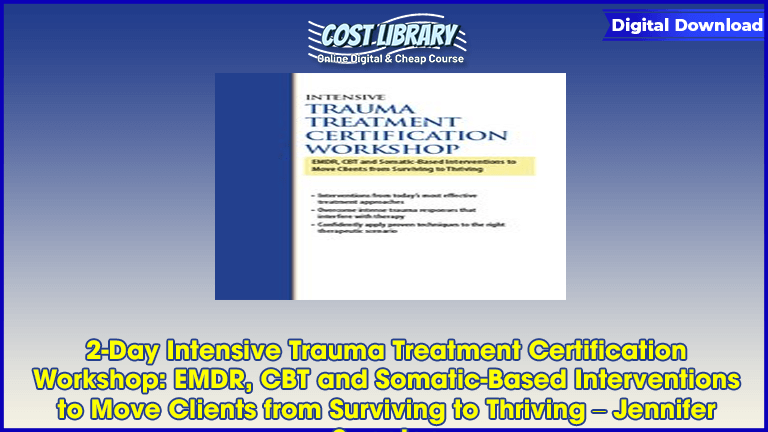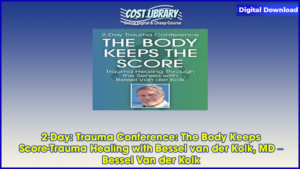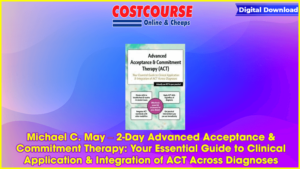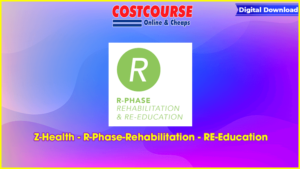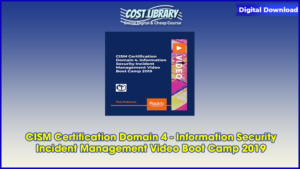2-Day Intensive Trauma Treatment Certification Workshop: EMDR, CBT and Somatic-Based Interventions to Move Clients from Surviving to Thriving – Jennifer Sweeton
Transform your practice with this intensive Certification Workshop recording that will provide you with effective strategies and interventions from EMDR, CBT, somatic approaches, and narrative therapy so you can take your trauma treatment to the next level!
You’ll learn how to properly assess clients, effectively stabilize them in preparation for treatment, help them safely reprocess traumatic memories, and develop the resources they need to achieve and maintain recovery. You’ll also get detailed guidance on overcoming scenarios involving anger, resistance, and suicidality that can leave you exhausted and uncertain of how to move your most challenging clients forward.
Better still, completion of this recording meets the educational requirements when applying to become a Certified Clinical Trauma Professional, giving you the opportunity to differentiate yourself from the crowd and let clients and colleagues know that you’ve invested the time and effort needed to provide treatment at the highest level.
Get the proven tools and techniques needed to end the suffering of your clients and move them from surviving to thriving!
Become a Certified Clinical Trauma Professional through the IATP (www.traumapro.net).
Three steps to becoming a Certified Clinical Trauma Professional (CCTP-Level 1):
Complete this training recording
Pay the $99.99 certification charge at the IATP website (www.traumapro.net)
Submit CEU Certificate from Step 1 and Professional License to [email protected].
Analyze the brain regions involved in trauma.
Communicate the clinical implications of the freeze response in trauma treatment.
Establish how clinicians can assess for simple, complex, and intergenerational trauma.
Characterize how bottom-up techniques like grounding and breathwork can increase felt safety in clients.
Specify methods clinicians can use to gauge when clients are ready for intense trauma work.
Explore how narrative therapy exercises can be employed in session to help clients talk about hotspots.
Specify how somatic approaches can be used to address the physical symptoms of trauma survivors.
Establish how exposure, titration and pendulation can be used to “slow†emotions in clients.
Communicate how EMDR-based techniques can be used with clients to resolve traumatic memories.
Differentiate between EMDR, EFT and neuromodulation approaches.
Develop plans for working with anger, resistance, and suicidality in clients who’ve experienced trauma.
Communicate the potential risks and limitations of trauma treatment techniques.
The Neuroscience of Trauma and Mechanisms of Change
Key brain areas involved in trauma
Fight, flight, freeze, fawn survival responses
Clinical implications of the freeze response
The neuroscience of EMDR, exposure therapy and cognitive therapy
Connect Clients to a Diagnosis: Trauma Assessment Tools
Simple vs. complex trauma
Intergenerational trauma
Symptom clusters and physical manifestations
CAPS-5 and PCL-5
Primary Care PTSD Screen
Dual diagnosis
Stabilize Your Clients Prior to Trauma Work
Trauma treatment roadmap – order of operations
Bottom-up techniques to reconnect and feel safe in the body
Self-soothing techniques
Grounding strategies
Breathwork
Gauge when a client is ready for intense trauma/cognitive work
Proven Skills and Techniques from Evidence-Based Approaches:
Somatic Approaches: Address Physical Symptoms of Trauma
Relevance of Polyvagal theory and early trauma
Assess for readiness to apply somatic tools
Teach body awareness
Manage unease with “Felt sense†exercises
Resourcing strategies to create a safe space
CBT Coping Skills: Manage Emotions
Identify inaccurate trauma-related cognitions
Exposure, titration and pendulation to slow emotions
Cognitive reframing and reappraisal interventions
Memory reconstruction techniques
EMDR-Based Techniques: Resolve Traumatic Memories
Adaptive Information Processing Theory EMDR vs EFT vs neuromodulation
Resourcing strategies
Combine memory reprocessing with cognitive restructuring
Using “restricted processing†with complex trauma
Narrative Therapy Exercises: Rewrite Traumatic Experiences
Interventions to help clients talk about hotspots
Reclaim identity with the “Tree of life†exercise
Awareness and closure – create life stories
Solutions to Trauma Treatment Roadblocks
How to handle the angry client
Strategies for the resistant trauma client
Boundary concerns
Dealing with crises, suicidality, substance use
Reintegration and Post-Traumatic Growth
Better than normal – the neuroscience of post-traumatic growth
The therapeutic alliance as a brain-based approach
The power of forgiveness in moving forward
Meaning making exercises
Research, Limitations and Potential Risks

